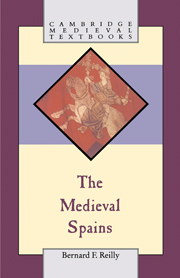Book contents
- Frontmatter
- Contents
- Maps
- 1 At the edge of empire
- 2 The Germanic kingdom in Iberia, 569–711
- 3 Iberia and the dār-al-Islam, 711–1009
- 4 Christian reconquista and African Empire, 1009–1157
- 5 The definition of Iberian autonomy: 1157–1295
- 6 The evolution of the medieval order in Iberia
- 7 The passing of medieval Iberia, 1248–1474
- An introductory bibliography
- Index
- Cambridge Medieval Textbooks
5 - The definition of Iberian autonomy: 1157–1295
Published online by Cambridge University Press: 05 June 2012
- Frontmatter
- Contents
- Maps
- 1 At the edge of empire
- 2 The Germanic kingdom in Iberia, 569–711
- 3 Iberia and the dār-al-Islam, 711–1009
- 4 Christian reconquista and African Empire, 1009–1157
- 5 The definition of Iberian autonomy: 1157–1295
- 6 The evolution of the medieval order in Iberia
- 7 The passing of medieval Iberia, 1248–1474
- An introductory bibliography
- Index
- Cambridge Medieval Textbooks
Summary
The death of Alfonso VII, el Emperador, of León–Castile in 1157 marked the end of four decades of triumphant progress on the part of the Christian principalities of the north of Iberia and the beginning of another six decades of the painstaking consolidation of prior gains in the face of considerable adversity. All things considered, the pause in that expansion was beneficial. The resources then to hand long proved barely adequate to maintain stability in the northern principalities, already swollen beyond all recognition from their shape and size even at the beginning of the twelfth century. That is not to suggest that fellows of our species were any more inclined than we to recognize the merits of moderation or the foolishness of the gambler's throw. Rather, this fortunate restraint was forced upon them by the new strength of their enemies and the crippling contradictions inherent in their own constructions.
The newfound vigor of the most obvious enemy, Islam, came from a familiar source. For the prior seventy years the military and political potency of al-Andalus had resided in the Moroccan empire of the Murābit of which it had become a part. For most of that time, the reigns of Yūsuf ibn Tāshufīn (1070–1106) and of his son Alī ibn Yūsuf (1106–1143), the Murābit emirs had ruled strongly but had been unable either to define the religious mission of their movement once it had become victorious or, alternatively, to construct a frankly political structure that could capture the consent of those beyond the family and tribal complex that was the government.
- Type
- Chapter
- Information
- The Medieval Spains , pp. 129 - 159Publisher: Cambridge University PressPrint publication year: 1993

